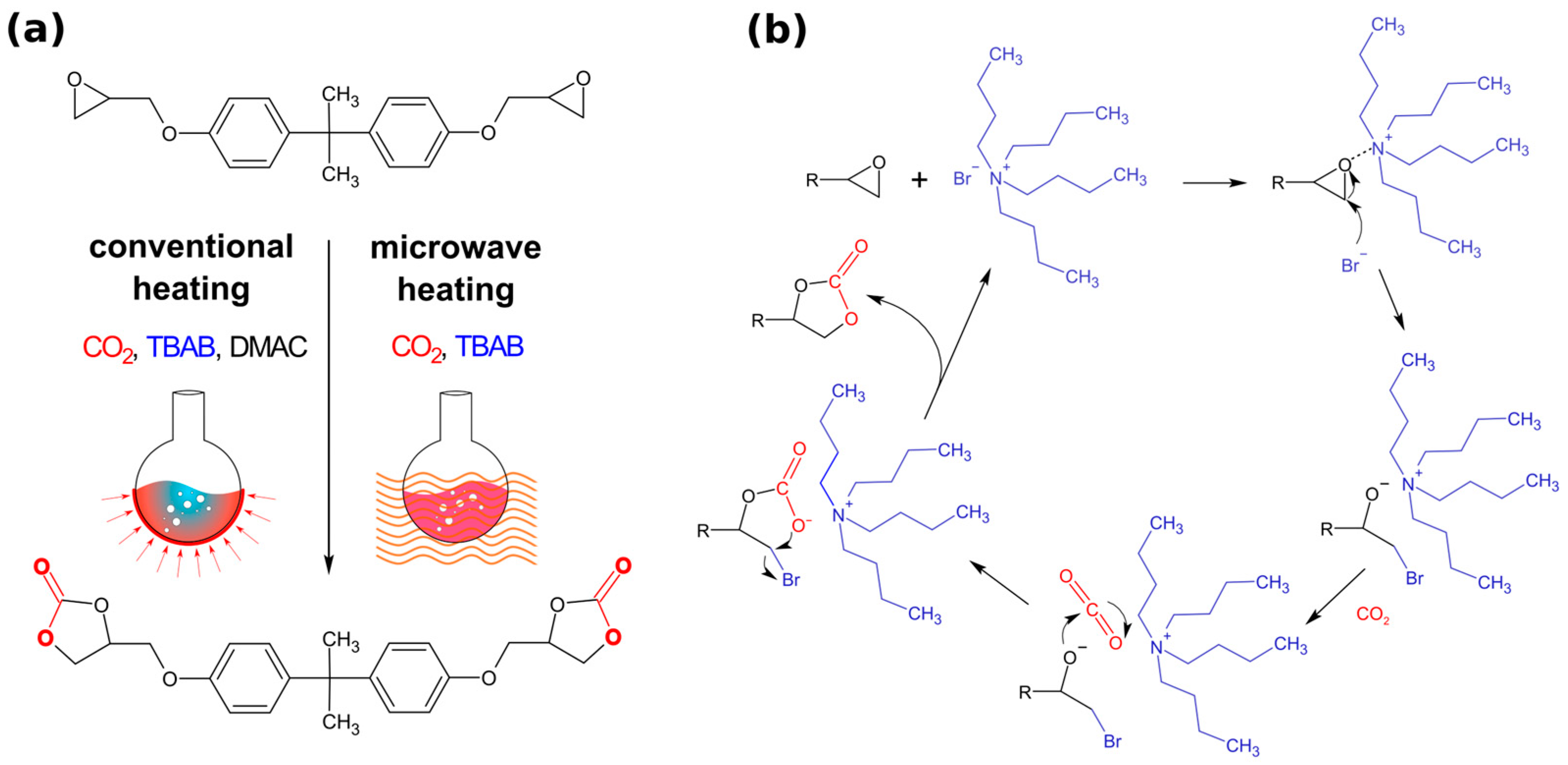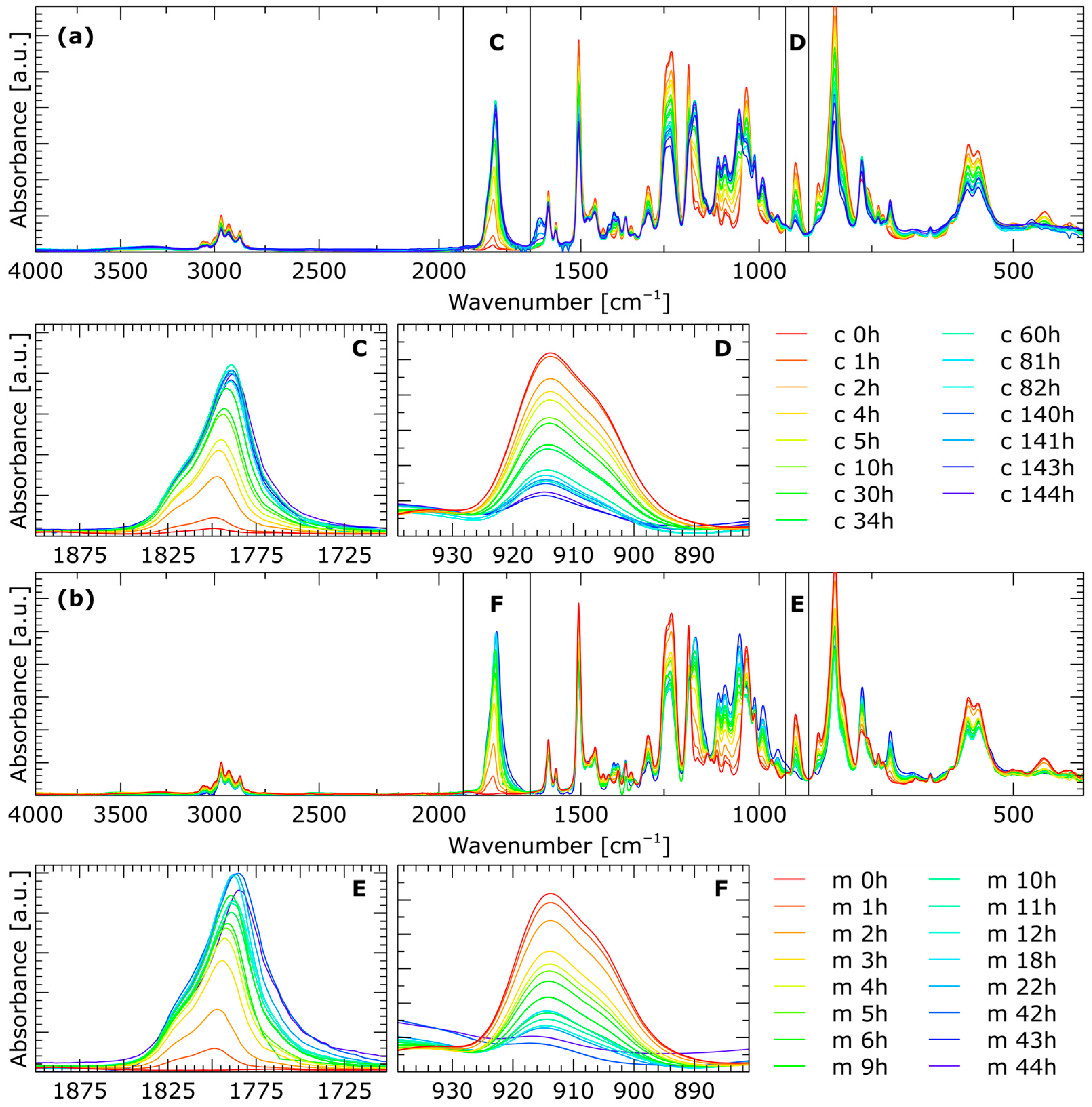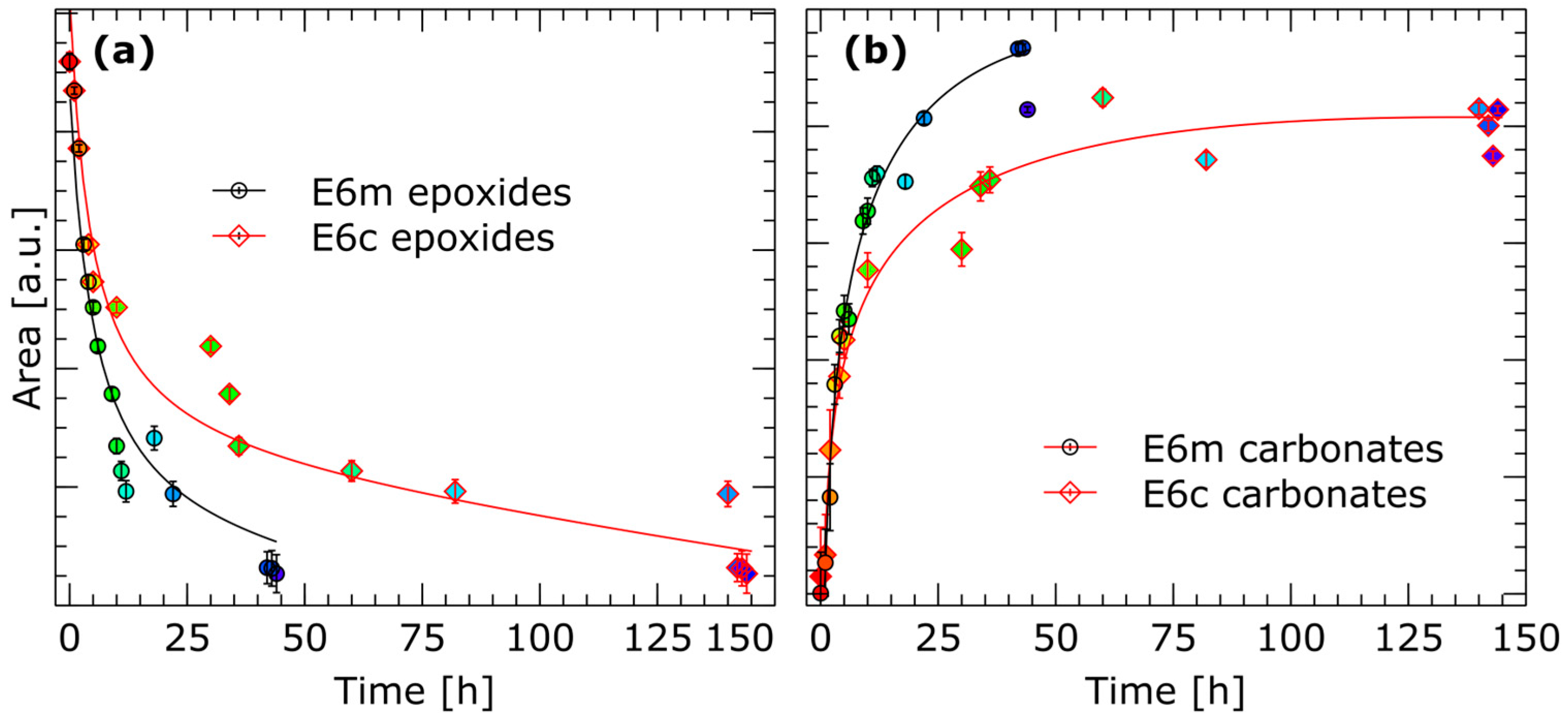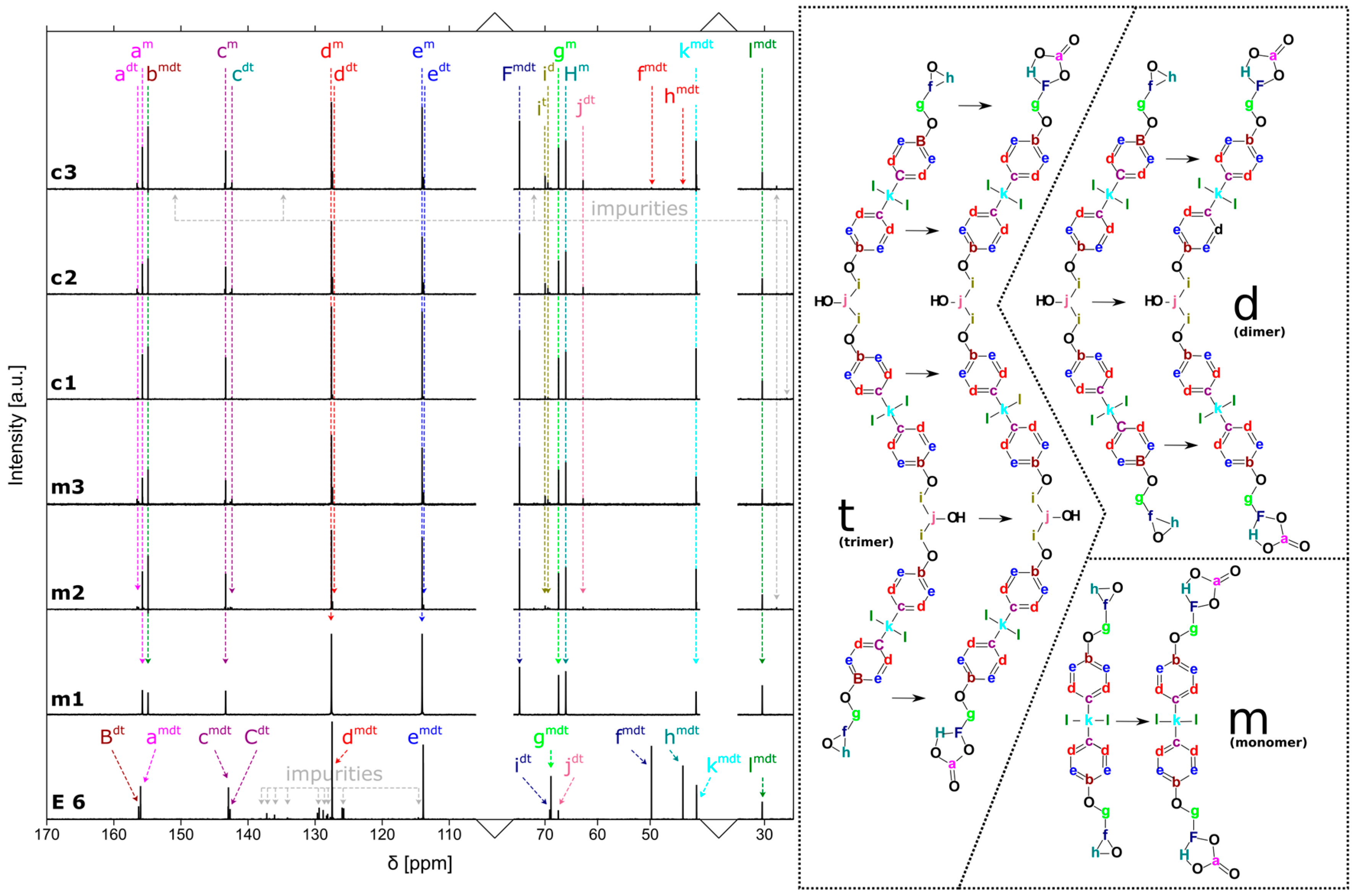Synthesis of Bis(cyclic carbonates) from Epoxy Resin under Microwave Irradiation: The Structural Analysis and Evaluation of Thermal Properties
Abstract
1. Introduction
2. Results and Discussion
3. Materials and Methods
3.1. Materials
3.2. Synthesis of BPA Bis(cyclic carbonate) under Conventional Conditions
3.3. Synthesis of BPA Bis(cyclic carbonate) under Microwave Radiation Conditions
3.4. Purification of the Obtained Crude Bis(cyclic carbonates)
3.5. Methods
3.5.1. FT-IR
Estimation of CC mol Concentration in 100 g of Product
- CCcont is a molar amount of cyclic carbonate groups in 100 g of the product;
- NA1786 is a normalized surface of the peak 1786 cm−1 from νC=O from cyclic carbonates.
3.5.2. NMR
3.5.3. TG
3.5.4. GPC
4. Conclusions
Supplementary Materials
Author Contributions
Funding
Institutional Review Board Statement
Informed Consent Statement
Data Availability Statement
Acknowledgments
Conflicts of Interest
References
- Zhao, Y.; Qian, X.; Zhao, X.; Zhang, Z. Hydrogenation of carbon dioxide under atmospheric pressure and low temperature. Int. J. Hydrogen Energy 2018, 43, 3062–3069. [Google Scholar] [CrossRef]
- Joos, F.; Spahni, R. Rates of change in natural and anthropogenic radiative forcing over the past 20,000 years. Proc. Natl. Acad. Sci. USA 2008, 105, 1425–1430. [Google Scholar] [CrossRef] [PubMed]
- Kumar, M.; Sundaram, S.; Gnansounou, E.; Larroche, C.; Thakur, I.S. Carbon dioxide capture, storage and production of biofuel and biomaterials by bacteria: A review. Bioresour. Technol. 2018, 247, 1059–1068. [Google Scholar] [CrossRef] [PubMed]
- Stewart, C.; Hessami, M.A. A study of methods of carbon dioxide capture and sequestration—The sustainability of a photosynthetic bioreactor approach. Energy Convers. Manag. 2005, 46, 403–420. [Google Scholar] [CrossRef]
- Błażek, K.; Beneš, H.; Walterová, Z.; Abbrent, S.; Eceiza, A.; Calvo-Correasc, T.; Datta, J. Synthesis and structural characterization of bio-based bis(cyclic carbonate)s for the preparation of non-isocyanate polyurethanes. Polym. Chem. 2021, 12, 1643–1652. [Google Scholar] [CrossRef]
- Decortes, A.; Castilla, A.M.; Kleij, A.W. Salen-complex-mediated formation of cyclic carbonates by cycloaddition of CO2 to epoxides. Angew. Chem. Int. Ed. 2010, 49, 9822. [Google Scholar] [CrossRef]
- North, M.; Pasquale, R.; Young, C. Synthesis of cyclic carbonates from epoxides and CO2. Green Chem. 2010, 12, 1514. [Google Scholar] [CrossRef]
- Webster, D.C. Cyclic carbonate functional polymers and their applications. Prog. Org. Coat. 2003, 47, 77. [Google Scholar] [CrossRef]
- Doley, S.; Agarwal, V.; Bora, A.; Borah, D.; Dolui, S.K. Development of sunflower oil-based nonisocyanate polyurethane/Multiwalled carbon nanotube composites with improved physico-chemical and microwave absorption properties. Polym. Compos. 2019, 40, 1120–1130. [Google Scholar] [CrossRef]
- He, X.; Xu, X.; Wan, Q.; Bo, G.; Yan, Y. Solvent- and catalyst-free synthesis, hybridization and characterization of biobased nonisocyanate polyurethane (NIPU). Polymers 2019, 11, 1026. [Google Scholar] [CrossRef]
- Figovsky, O.L.; Shapovalov, L.; Blank, N.; Buslov, F. New Polyfunctional Polycyclocarbonate Oligomers Useful in Coatings, Adhesives, Composite Materials Sealants and Synthetic Leather. European Patent EP1020457-A, 19 July 2006. [Google Scholar]
- Figovsky, O.L. Producing Hybrid Nonisocyanate Polyurethane Networks. U.S. Patent US6120905-A, 15 January 1999. [Google Scholar]
- Guan, J.; Song, Y.; Lin, Y.; Yin, X.; Zuo, M.; Zhao, Y.; Tao, X.; Zheng, Q. Progress in Study of Non-Isocyanate Polyurethane. Ind. Eng. Chem. Res. 2011, 50, 6517–6527. [Google Scholar] [CrossRef]
- Cornille, A.; Dworakowska, S.; Bogdał, D.; Boutevin, B.; Caillol, S. A new way of creating cellular polyurethane materials: NIPU foams. Eur. Polym. J. 2015, 66, 129–138. [Google Scholar] [CrossRef]
- Tomita, H.; Sanda, F.; Endo, T. Model reaction for the synthesis of polyhydroxyurethanes from cyclic carbonates with amines: Substituent effect on the reactivity and selectivity of ring opening direction in the reaction of five-membered cyclic carbonates with amine. J. Polym. Sci. Part A Polym. Chem. 2001, 39, 3678–3685. [Google Scholar] [CrossRef]
- Garipov, R.; Sysoev, V.; Mikheev, V.; Zagidullin, A.; Deberdeev, R.Y.; Irzhak, V.; Berlin, A.A. Reactivity of cyclocarbonate groups in modified epoxy–amine compositions. In Doklady Physical Chemistry; Springer: Berlin/Heidelberg, Germany, 2003; pp. 289–292. [Google Scholar]
- Zabalov, M.V.; Tiger, R.P.; Berlin, A.A. Mechanism of urethane formation from cyclocarbonates and amines: A quantum chemical study. Russ. Chem. Bull. 2012, 61, 518–527. [Google Scholar] [CrossRef]
- Quérette, T.; Fleury, E.; Sintes-Zydowicz, N. Non-isocyanate polyurethane nanoparticles prepared by nanoprecipitation. Eur. Polym. J. 2019, 114, 434–445. [Google Scholar] [CrossRef]
- Jalilian, S.; Yeganeh, H. Preparation and properties of biodegradable polyurethane networks from carbonated soybean oil. Polym. Bull. 2015, 72, 1379–1392. [Google Scholar] [CrossRef]
- Beniah, G.; Liu, K.; Heath, W.H.; Miller, M.D.; Scheidt, K.A.; Torkelson, J.M. Novel thermoplastic polyhydroxyurethane elastomers as effective damping materials over broad temperature ranges. Eur. Polym. J. 2016, 84, 770–783. [Google Scholar] [CrossRef]
- Hahn, C.; Keul, H.; Moeller, M. Hydroxyl-functional polyurethanes and polyesters: Synthesis, properties and potential biomedical application. Polym. Int. 2012, 61, 1048–1060. [Google Scholar] [CrossRef]
- Proempers, G.; Keul, H.; Hoecker, H. Polyurethanes with pendant hydroxy groups: Polycondensation of D-mannitol-1,2:5,6-dicarbonate with diamines. Des. Monomers Polym. 2005, 8, 547–569. [Google Scholar] [CrossRef]
- Razali, N.; Ali, F.; Azmi, A.S.; Ismail, T.N.; Anuar, H.; Jamaluddin, J. Polyurethane: Green Chemistry Synthesis, Application and Biodegradability—A Review. J. Polym. Sci. Technol. 2022, 7, 13–30. [Google Scholar]
- Bogdal, D. Microwave-Assisted Organic Synthesis: One Hundred Reaction Procedures; Elsevier Science: Amsterdam, The Netherlands, 2005; pp. 1–214. [Google Scholar]
- Hwang, J.Z.; Chen, C.-L.; Huang, C.-Y.; Yeh, J.-T.; Chen, K.-N. Green PU resin from an accelerated Non-isocyanate process with microwave radiation. J. Polym. Res. 2013, 20, 195. [Google Scholar] [CrossRef]
- Leadbeater, N.E.; Torenius, H.M. A study of the ionic liquid mediated microwave heating of organic solvents. J. Org. Chem. 2002, 67, 3145. [Google Scholar] [CrossRef] [PubMed]
- Yang, P.-L.; Tsai, S.-H.; Chen, K.-N.; Wong, D.S. A New continuous flow microwave radiation process design for non-isocyanate polyurethane (NIPU). Polymers 2023, 15, 2499. [Google Scholar] [CrossRef] [PubMed]
- Zhang, C.; Huang, K.-C.; Wang, H.; Zhou, O. Anti-corrosion non-isocyanate polyurethane polysiloxane organic/inorganic hybrid coatings. Prog. Org. Coat. 2020, 148, 105855. [Google Scholar] [CrossRef]
- Zhou, P.; Yang, X.; Zhai, Y.; Jia, G. Synthesis of cyclic carbonates from epoxides using sodium bicarbonate under microwave irradiation. Curr. Microw. Chem. 2015, 2, 159–165. [Google Scholar] [CrossRef]
- Dharman, M.M.; Choi, H.-J.; Kim, D.-W.; Park, D.-W. Synthesis of cyclic carbonate through microwave irradiation using silica-supported ionic liquids: Effect of variation in the silica support. Catal. Today 2011, 164, 544–547. [Google Scholar] [CrossRef]
- Yang, X.; Wu, J.; Mao, X.; Jamison, T.F.; Hatton, T.A. Microwave assisted synthesis of cyclic carbonates from olefins with sodium bicarbonates as the C1 source. Chem. Commun. 2014, 50, 3245. [Google Scholar] [CrossRef]
- Loupy, A.; Régnier, S. A versatile new synthesis of 4-aryland heteroaryl-[3,4-c]pyrrolocarbazoles by [4+2] cycloaddition followed by palladium catalysed cross coupling. Tetra. Lett. 1999, 40, 6221. [Google Scholar] [CrossRef]
- Rehmana, A.; Ezea, V.C.; Gunam Resul, M.F.M.; Harvey, A. Kinetics and mechanistic investigation of epoxide/CO2 cycloaddition by a synergistic catalytic effect of pyrrolidino pyridinium iodide and zinc halides. J. Energy Chem. 2019, 37, 35–42. [Google Scholar] [CrossRef]
- North, M.; Pasquale, R. Mechanism of cyclic carbonate synthesis from epoxides and CO2. Angew. Chem. 2009, 121, 2990–2992. [Google Scholar] [CrossRef]
- Błażek, K.; Datta, J.; Alicja Cichoracka, A. Sustainable synthesis of cyclic carbonates from bio-based polyether polyol: The structure characterization, rheological behaviour and thermal properties. Polym. Int. 2019, 68, 1968–1979. [Google Scholar] [CrossRef]
- Ke, J.; Li, X.; Wang, F.; Jiang, S.; Kang, M.; Wang, J.; Lia, Q.; Wang, Z. Non-isocyanate polyurethane/epoxy hybrid materials with different and controlled architectures prepared from a CO2-sourced monomer and epoxy via an environmentally friendly route. RSC Adv. 2017, 7, 28841. [Google Scholar] [CrossRef]
- Liu, B.; Zhao, X.; Wang, X.; Wang, F. Thermal degradation kinetics of poly(propylene carbonate) obtained from the copolymerization of carbon dioxide and propylene oxide. J. Appl. Polym. Sci. 2003, 90, 947–953. [Google Scholar] [CrossRef]






| Sample | mol CC/100 g |
|---|---|
| m1 | 0.232 |
| m2 | 0.218 |
| m3 | 0.223 |
| c1 | 0.161 |
| c2 | 0.126 |
| c3 | 0.132 |
| Sample | Tonset (°C) | TDTG max1 (°C) | TDTG max2 (°C) | TDTG max3 (°C) | DTG max1 (%/min) | DTG max2 (%/min) | DTG max3 (%/min) | m1 (%) | m2 (%) | m3 (%) | Residual Mass (%) |
|---|---|---|---|---|---|---|---|---|---|---|---|
| E6 | 276.5 | - | 310.0 | 396.6 | - | −21.9 | −2.3 | - | −83.1 | −15.8 | 1.0 |
| m1 | 222.5 | 249.0 | 330.2 | 419.3 | −2.3 | −15.0 | −3.6 | −11.7 | −63.8 | −21.8 | 2.6 |
| m2 | 219.1 | 246.6 | 330.4 | 405.4 | −2.4 | −15.1 | −3.7 | −10.6 | −64.2 | −23.4 | 1.8 |
| m3 | 222.9 | 252.3 | 330.0 | 417.0 | −2.2 | −14.7 | −4.2 | −12.5 | −63.8 | −22.3 | 3.8 |
| c1 | 211.7 | 240.6 | 338.1 | 426.2 | −2.9 | −10.0 | −4.7 | −15.6 | −58.4 | −23.6 | 2.4 |
| c2 | 212.1 | 244.4 | 324.9 | 432.4 | −2.1 | −7.6 | −7.2 | −13.1 | −43.0 | −39.3 | 4.6 |
| c3 | 215.4 | 246.9 | 318.1 | 415.0 | −2.3 | −6.3 | −8.2 | −10.1 | −38.0 | −42.7 | 6.8 |
| Samples | Peak I | Peak II | Peak III |
| Mn(theoretical) = 428 [g mol−1] | Mn(theoretical) = 712 [g mol−1] | Mn(theoretical) = 997 [g mol−1] | |
| Mn(experimental) = 504 [g mol−1] | Mn(experimental) = 731 [g mol−1] | Mn(experimental) = 1052 [g mol−1] | |
| Mass fraction (%) | Mass fraction (%) | Mass fraction (%) | |
| m1 | 93.6 | 4.3 | 2.1 |
| m2 | 78.5 | 15.4 | 6.1 |
| m3 | 84.5 | 14.1 | 1.4 |
Disclaimer/Publisher’s Note: The statements, opinions and data contained in all publications are solely those of the individual author(s) and contributor(s) and not of MDPI and/or the editor(s). MDPI and/or the editor(s) disclaim responsibility for any injury to people or property resulting from any ideas, methods, instructions or products referred to in the content. |
© 2024 by the authors. Licensee MDPI, Basel, Switzerland. This article is an open access article distributed under the terms and conditions of the Creative Commons Attribution (CC BY) license (https://creativecommons.org/licenses/by/4.0/).
Share and Cite
Hebda, E.; Ozimek, J.; Szołdrowska, K.; Pielichowski, K. Synthesis of Bis(cyclic carbonates) from Epoxy Resin under Microwave Irradiation: The Structural Analysis and Evaluation of Thermal Properties. Molecules 2024, 29, 250. https://doi.org/10.3390/molecules29010250
Hebda E, Ozimek J, Szołdrowska K, Pielichowski K. Synthesis of Bis(cyclic carbonates) from Epoxy Resin under Microwave Irradiation: The Structural Analysis and Evaluation of Thermal Properties. Molecules. 2024; 29(1):250. https://doi.org/10.3390/molecules29010250
Chicago/Turabian StyleHebda, Edyta, Jan Ozimek, Kinga Szołdrowska, and Krzysztof Pielichowski. 2024. "Synthesis of Bis(cyclic carbonates) from Epoxy Resin under Microwave Irradiation: The Structural Analysis and Evaluation of Thermal Properties" Molecules 29, no. 1: 250. https://doi.org/10.3390/molecules29010250
APA StyleHebda, E., Ozimek, J., Szołdrowska, K., & Pielichowski, K. (2024). Synthesis of Bis(cyclic carbonates) from Epoxy Resin under Microwave Irradiation: The Structural Analysis and Evaluation of Thermal Properties. Molecules, 29(1), 250. https://doi.org/10.3390/molecules29010250






